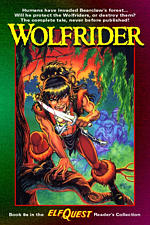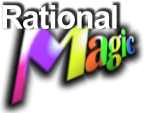

| Elfquest: Wolfrider. Written by Christie Marx and Wendy Pini. Illustrated by Wendy Pini and Jeff Zugale. Poughkeepsie, NY: Warp Graphics, 1999. 1v. (unpaged). (Elfquest Reader's Collection, Book 9a). $11.95. ISBN 0-936861-67-3. |

|
GENRES: AUDIENCE: SYNOPSIS: A human hunting party kills a mother wolf and her cubs, taking one alive to serve the new young Shaman who will be anointed this night. In retaliation, Bearclaw waits until the humans have drunk themselves into a stupor, then sneaks into their camp and tries to terrify the young Shaman by dressing up in their sacred bearskin. But though he retrieves the wolf cub and escapes, Bearclaw has again only made the humans angrier. They renew their vow to kill the elves. Several years pass. The humans stubbornly remain in the elves' wood despite their tricks. By hiding in the shadows near the humans, the elves pick up the humans' tongue, hoping to someday reason with them. However, Woodrue has his eye put out by men (thus becoming One-Eye), and soon afterwards, Crescent (Strongbow and Moonshade's daughter) is brutally murdered. Restraining the hysterical Strongbow from rushing to the attack, Bearclaw goes alone to the humans' camp and kills the old Shaman as he enters the forest. Joyleaf is furious with Bearclaw for making things worse, and in a rage he rushes to the trolls underground lair and drinks himself into a stupor. Things get even worse for Bearclaw when the humans leave poisoned meat around, and his beloved wolf-friend Snapper dies as a result. Joyleaf manages to catch him before he runs off to seek revenge; over the objections of Strongbow, she ties Bearclaw up and tries to talk sense into his head--pointing out that when he rushes "headlong and heedless into danger, you forget tribe and kin and act only on your own selfish desires." Freed, Bearclaw looks for a sign from the High Ones about what to do, and a jet-black wolf appears. They bond instantly, and Bearclaw takes him as a sign to continue the fight with the humans. The elves (usually Bearclaw and Strongbow) embark on a series of raids, forcing the humans' hunters to range farther and farther to find food. The young Shaman, sensing a "loss of spirit" among his people, begins to train young boys in demon-hating, and the elves Shale and Eyes-High die as a result, though the babe Skywise is rescued. Bearclaw is also losing spirit and spends more and more time with the trolls, gaming and drinking. Returning from one of these forays, he is confronted by Joyleaf, who accuses him of abandoning the tribe. He hits her, and she refuses to either talk or sleep with hm any longer. Their feud lasts for a long time, until he commands her to fight bear with him. When he trips while outrunning the bear, Joyleaf forgets her anger and kills the bear to save her lifemate. Their bonds renewed, they feel the pull of Recognition, and their subsequent union produces Cutter. During a particularly cold and harsh winter, the elves find that the humans have left the area. Cutter is thus born into a time of unusual peace for the elves, and he never learns to hate them as most of the tribe does. Unfortunately, the humans eventually return, led by the fanatical Shaman, and declare sacred war. A hunting party ambushes Brownberry and Foxfur. They escape, but the tribe is shaken--and leaderless, with Bearclaw again drunk with the trolls. Cutter, wishing to prove his maturity, approaches the humans with intent to parlay. But they attack him on sight, and he is nearly killed before a party of elves rescue him. When Bearclaw returns, he finds an angry tribe awaiting him. Shamed, he takes a solemn vow never to visit the trolls again. However, he tries to finish what Cutter started by attempting a parlay with the Shaman. The parlay degenerates into a shouting match and then a fight that is only broken up by a lightning strike. The hatred and the lightning combine with a stagnant pool of magic, and the resulting sick mixture eventually produces the horrible Madcoil, the cat-snake that would eventually wipe out a number of the elves and claim the lives of both Joyleaf and Bearclaw before falling to the combined might of the elves under Cutter's leadership. A short afterword by Wendy Pini explains how she wanted to flesh out the "irascible but lovable" sire of Cutter, who before this was known only through Cutter's memories and the brief "Madcoil" sequence (which is retold from a slightly different point of view in Wolfrider) told just after the Wolfriders arrived at Sorrow's End (Book 1: Fire and Flight). EVALUATION: The story is intriguing for more than the light it sheds on these crucial historical characters; it also paints a very nice (and sad) portrait of how two groups of people can progress from distrust to anger to hate, and how the actions of a few individuals can exacerbate the situation. For although we certainly sympathize with Bearclaw's murder of the first Shaman, we also know that Joyleaf is indeed right: the Shaman's death will only bring more death and destruction upon the elves. Unfortunately for the elves, Bearclaw is too short-sighted, too bent on revenge, to see this. But the humans' irrational fear and hatred of the "demons" is also responsible for much harm; neither side is innocent. (This is one thing I really like about Elfquest--the "full-color" view of the world, rather than the "black-and-white" good vs. evil, that existed even in the very earliest material.) When Bearclaw finally accepts that it would be better to move the Holt than to continue to fight the humans, the tribe is decimated by Madcoil--the embodiment of his and the Shaman's hatred. (Talk about "what goes around comes around"!) I have to admit that I didn't care for Jeff Zugale's art, though admittedly he worked at a disadvantage, with his chapters sandwiched between Wendy Pini's classic drawings. That's a hard act to follow! But I thought his style was a little cartoony for this series; his human figures weren't fluid enough, and his faces weren't subtle in their emotion--and he drew all the female elves with really thick lips for some reason, so my eye was drawn to those minor and distracting elements. In his favor, however, he did make the elves visually distinct from one another, something that a few of the artists on the subsequent books failed to accomplish. Overall, however, this book is up to the standards of the previous ones. It could be read in order of publication, or it could be read after Fire and Flight without being confusing. Obviously a must purchase. |
Return to Rational Magic Home
